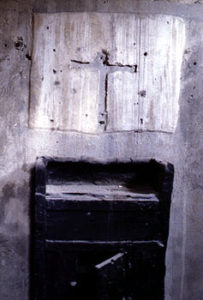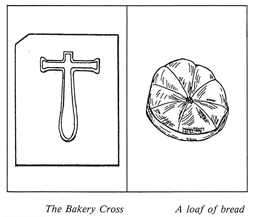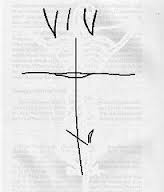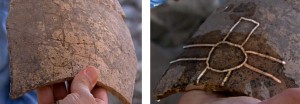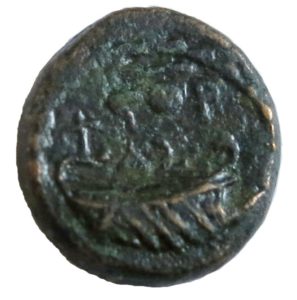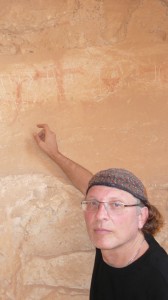Christians at Masada!
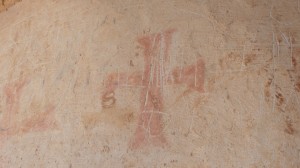
It’s time that we repopulate ancient Israel with the people who actually lived here. Of course, the Jewish people, but there were also Syro-Phoenicians, Canaanites, Nabateans, Samarians and – yes – Christians. If there were no Christians then, there would be no Christians today. It’s as simple as that.
And yet, archaeologists and historians don’t want to find them. Why? Because the Jesus of history i.e., the Jesus that the early followers had known, may not match the “Christ” of Christian theology.
One of the best ways to get rid of early followers of Jesus from the historical record is to dismiss the cross as an early Christian symbol. That way, whenever you find a cross, it’s just an “X”. Talk to scholars of Christianity and most of them will tell you that in the early days of the movement the cross was a negative symbol, representing Jesus’ suffering. According to these scholars, the fish was the earliest positive Christian symbol. Only in the 4th century, they say, did the cross become a Christian symbol. So the way the circular archaeological game goes; if it’s early it’s not a cross, and if it’s a cross, it’s not early.
In the 4th century, the Roman Emperor Constantine became involved with Christianity. In 325 CE, he convened a council at a place called Nicaea, in modern day Turkey, and basically elevated one form of Christianity – the one that we know – over all others. Whatever did not fit the official creed was labeled a “heresy”, and we know what happened to the heretics. In other words, according to scholars, it is only when orthodoxy wins out that the cross becomes the symbol of the faith.
But it’s time to face the facts. It’s time to admit that the cross was already a Christian symbol in the 1st century when some of Jesus’ earliest followers were still around. It’s time to reevaluate all the archaeology that had previously been dismissed. It’ll tell us a story of Christianity that has been overlooked and suppressed.
So here’s some of the evidence:
- The cities of Pompeii and Herculaneum were destroyed in a volcanic eruption in August of 79. At Herculaneum, a cross was found in front of some kind of prayer lectern. Clearly, it was found in a place of worship. Scholars dismiss this cross as the remains of a shelf.
- In Pompeii, a clear, very large, Christian cross was found in a bakery. To the best of my knowledge, it has only been published by Italian scholars. As a result, Anglo scholars have ignored it. Here it is as reconstructed by Francesco Paolo Maulucci, Pompeii: Archaeological Guide to the Excavations of Pompeii with Itineraries, Plans and Reconstructions (Carcavallo, 1987) on p. 69.
- The best 1st century Christian cross is from Pompeii where it was found in a graffito in a courtyard. It has “Viv” inscribed at the top, probably short for the Latin “Vivat” i.e., “live!” This is clearly Christian and clearly 1st century but, to the best of my knowledge, it’s been published only in Italian (See Maulucci, Francesco Paolo, Pompei: I graffiti figurati. Bastogi, 1993, p. 194).
- At Bethsaida in the Galilee, where Professors Rami Arav and Richard Freund have been digging for decades, and where I’m now a co-director on behalf of Huntington University, a clear cross has been found on a 1st century vase. Bethsaida is the place of the “first supper”, if you will. It is mentioned in the Gospels as the home of at least three of Jesus’ twelve disciples. The cross was found next to a fishermen complex and in the only building in the town that could have served as an early “house church”.
And now my numismatist (coin guy) friend David Wray, has drawn my attention to a 1st century coin from his collection. It was minted in the year 72 CE in Ashkelon, 40 miles north of Jerusalem on the Mediterranean coast. It probably represents a “private minting” by a wealthy Roman convert to Christianity.
It depicts a galley with a cross. In ancient times, as on the coin, it was on the prow that sailors mounted religious objects. On this boat, the cross is clearly given a place of religious honor. The date is significant. It is 7 years earlier than the crosses in Pompeii and Herculaneum. When this coin was minted, the Temple in Jerusalem, which had been torched in the year 70, was still smoldering and the Sicarii, the dreaded Jewish revolutionary faction, was still holding out against Roman Imperial power at the rock fortress at Masada. When this coin was minted the Sicarii were still one year away from their collective suicide in the face of imminent defeat. I repeat, this coin was minted when Masada was still standing! It was minted only 40 years after Jesus’ crucifixion and only 10 years after the stoning of James, brother of Jesus. Christian crosses just don’t get earlier than this – unless they’re carved on Jesus’ ossuary. Despite the evidence, scholars will be loath to admit that there is a Christian cross on the coin. Why? Well, that would force them to reexamine the archaeology.
To understand how explosive this issue can become, consider this – archaeologists have found crosses painted in red in the southern caves of Masada. On flimsy evidence, they date them to the Byzantine period. Because of the possible ramifications of this find, to the best of my knowledge, the crosses have never been published. I reveal them here for the first time.
If the cross was already a Christian symbol in 72, the crosses at Masada may have been painted by some of the rebels themselves. This would require a total rethinking of Christians in the 1st century. Both Jewish and Christian scholars would like to think of the early followers of Jesus as pacifists who sat out the great revolt against Rome. That way, both Jews and Christians don’t have to deal with the ramifications of thinking of early Christians as Jewish patriots. Put differently, Jews don’t want to “Christianize” the rebels and Christians don’t want to “Judaize” the early Christians. Revisiting the archaeology might even force us to think of some of Jesus’ followers as Sicarii e.g., Judah “Iscariot”. And this might put the events leading up to the crucifixion in a totally new light. The evidence is mounting and it’s time we rethink our prejudices.
Click here to see my recent article “History Envy” on The Times of Israel.

